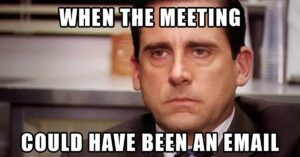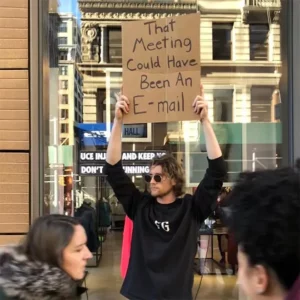Meetings can either be a powerful tool for collaboration or a drain of time and energy. The difference lies in how well they’re planned, directed, and justified. If you’ve ever sat in a meeting wondering, “Why wasn’t this just an email?” you’re not alone.
In this guide, you’ll learn to recognize the red flags indicating that this could have been an email. By learning this, you can avoid the traps that lead to inefficiency, and adopt strategies to make your meetings purposeful and impactful.
6 Persistent Signs of “This Could Have Been an Email” Meetings
While some meetings are necessary, others can be substituted by an email or even a Slack update. Let’s explore seven clear signs your meeting fits the this could have been an email meme scenario, along with actionable solutions.

1. One-Way Information Flow
You can spot another meeting that could’ve been an email when the meeting leader dominates the conversation, delivering updates or announcements with no room for interaction: a classic example where the meeting functions as a glorified broadcast session. Perhaps there’s a brief chat after the update, but nothing of real value comes from it.
What You Can Do
Replace one-sided meetings with updates via Slack or MS Teams. To confirm everyone has received the message, ask for reactions or conduct a quick poll. If the update is important, include it as a segment in a larger, more collaborative meeting.
2. Most Participants Stay Silent
You’ve probably experienced meetings where only a few voices dominate while others sit as spectators. For those silent participants, it’s often a waste of time that could have been spent more productively.
What You Can Do
Be intentional with your invites. Only include people whose input you’ll need. If you need to share the outcomes with a larger audience, use tools like AI-generated meeting summaries or transcriptions to distribute the key points later.
3. Everyone Quickly Agrees
When a group reaches a consensus immediately, it’s often a sign that the topic isn’t complex enough to require a meeting. A simple poll would have sufficed.
4. Lack of Agenda
Meetings without agendas often happen because someone decided to “figure it out” on the spot. This lack of structure is a key contributor to why are you like this meme moments and creates unnecessary time sinks.

5. Too Short to Be Useful
These kinds of discussions wrap up in under five minutes, leaving you wondering why it couldn’t have been handled via email. Try asynchronous updates or group emails for quick updates instead. If something truly needs to be addressed live, ensure there’s enough value-packed content to justify a meeting.
6. Recurring Aimlessly
Recurring meetings can easily lose their purpose and turn into rituals that waste your team’s time. If you dread these meetings, chances are others do too. That’s why, it’s crucial to audit such meetings every quarter. Ask whether they’re still serving their original purpose.
Now that you know the clear signs of meetings that could be emails, let’s pinpoint ways to replace them with more efficient options.
How to Prevent This Could Have Been an Email Meetings
If you make intentional changes to your scheduling and running meetings approach, you can reclaim time, boost productivity, and reduce frustration. Here are practical strategies to ensure meetings stay relevant and valuable.
1. Establish Meeting Behaviour Guidelines
Clear expectations are the foundation of productive meetings. Don’t underestimate the power of behavioral guidelines to create consistency during meetings:
- Encourage active participation.
For example, in brainstorming sessions, ask attendees to share ideas and build on others’ input to maintain momentum.
- Minimize disruptions.
Encourage attendees to hold questions until the end or submit them in writing for clarity.
- Keep updates brief and focused.
Limit deviations by saving detailed discussions for offline follow-ups.
- Foster respect and focus.
In feedback sessions or policy updates, encourage attentive listening and thoughtful questions to maintain professionalism.
- Ensure preparation.
Share agendas in advance and ask participants to review materials beforehand.
When you normalize these behaviors, your team becomes more mindful of avoiding this could have been an email scenario.
2. Prioritize a Culture of Note-Taking
Note-taking ensures everyone stays on the same page and provides clarity long after the meeting ends. It also prevents unnecessary participation and keeps everyone in the loop even without personally attending.
Besides, note-taking helps you avoid revisiting topics unnecessarily—one of the main culprits of this meeting could have been an email.
How to Automate Note-Taking for Meetings
You can automate note-taking with tools like Krisp. It not only precisely transcribes meetings live for you, but also turns those notes into actionable summaries.
For example, Krisp’s AI transcription feature can turn meeting discussions into concise, searchable notes, saving time and reducing the need for redundant follow-ups.
As you can see in the following demo, you can copy the entire meeting conversation and use it for multi-purpose needs, like creating surveys, content, or future agendas.
Alternatively, you can turn your notes into practical summaries to share with busier employees unable to attend the meeting. Moreover, Krisp’s smart technology can turn the conversation into action items while recording your meeting—specific tasks extracted from your discussion that you can later assign to different participants.
3. Create Well-Planned and Coordinated Agendas
An agenda is your roadmap to a focused and purposeful meeting. Without one, discussions can derail or, worse—become irrelevant. Always prepare an agenda in advance and share it with attendees, giving them time to review and contribute.
This practice helps eliminate those dreaded meetings that could be emails.
4. Assign Attendee Responsibilities During Meetings
When attendees have specific roles or responsibilities, they stay engaged and proactive.
Assign tasks like timekeeping, or presenting specific points to ensure everyone contributes meaningfully.
When roles are well-defined, participants are more likely to value the meeting and less likely to view it as another meeting that could’ve been an email.
5. Incorporate Asynchronous Communications
Asynchronous communication is your secret weapon against unnecessary meetings. Discussions that don’t require live interaction or brainstorming should happen in emails, Slack threads, or collaborative tools.
When you opt for asynchronous updates, you minimize the risk of side discussions spiraling into impromptu mini-meetings. For instance, a simple project update doesn’t need a live call when a shared document or detailed email will suffice. This approach reduces unnecessary time sinks and streamlines your workflow.
Meeting vs Email: When Are Meetings Truly Necessary?
When organized properly, a meeting can be an incredible source of value, but these days, it isn’t easy to decide between a meeting vs email. It is imperative to understand when an email is a better option for communication and when a meeting is more appropriate. Let’s break it down.
When to Send an Email
Emails are ideal for situations where communication doesn’t require immediate feedback or extensive collaboration. Opt for an email in these cases:
| 1 | Asynchronous Discussions | When the topic doesn’t demand real-time input, emails allow recipients to respond at their own pace. Examples include sharing updates, requesting feedback, or asking for information that isn’t time-sensitive. For all of this, you can do your research beforehand, to make a more confident, relevant, and sensible contribution. |
| 2 | Exchange of Basic Needs | For straightforward exchanges like providing resources, confirming schedules, or answering questions, emails are the most efficient medium. They eliminate the need for back-and-forth scheduling and save time. |
| 3 | Announcing Routine Updates | Regular announcements, such as policy changes, team achievements, or project milestones are better suited for emails. Adding these updates to a meeting minutes email can also ensure everyone stays informed. |
| 4 | Checking In | If you want to check on progress or confirm tasks, an email gets the job done without disrupting workflows. Sending a clear, concise email can help you stay updated without pushing people into unnecessary meetings. |
| 5 | Information Not Relevant to All | When the message only concerns specific individuals, an email ensures that only the relevant parties are looped in, avoiding the inefficiency of overpopulated meetings. |
When to Organize a Meeting
Meetings are necessary when real-time collaboration, decision-making, or nuanced communication is required. Here’s when a meeting is worth the time:
| 1 | Full Attendance Is Crucial | If a discussion requires input or agreement from all stakeholders, a meeting ensures everyone is aligned. This is especially important for strategic planning or high-stakes projects. |
| 2 | Sensitive Information Needs to Be Shared | Delivering sensitive or complex information, such as organizational changes or feedback, is best handled in a meeting. Face-to-face or virtual interactions allow for better tone and context—avoiding misunderstandings. |
| 3 | Urgency Is a Factor | When time is of the essence, a meeting provides immediate answers and decisions. For example, addressing a crisis or finalizing a deadline-driven task often benefits from direct communication. Here, it can be a means of risk management. |
| 4 | Brainstorming and Group Planning Needed | Collaborative sessions like brainstorming, strategic discussions, or problem-solving require dynamic, real-time input. Meetings foster creativity and ensure that ideas are thoroughly explored. |
By carefully evaluating the context, urgency, and nature of the information, you can decide whether to send an email or call a meeting. Striking this balance not only improves communication efficiency but also minimizes those meetings that could be emails moments.
The Toxic Effects of Bad Meetings
Poorly planned or unnecessary meetings don’t just waste time—they can damage team dynamics and productivity in ways that ripple across your organization.
1. Timewasting Workflows
When meetings drag on without clear objectives or actionable outcomes, they create bottlenecks. Employees lose time they could spend on meaningful work, leaving you with sluggish workflows.
2. Lack of Objectivity
Unstructured discussions can cloud decision-making. Without a focused agenda, participants may struggle to prioritize key issues or make data-driven decisions. Over time, this lack of clarity can lower confidence in the meeting process and leave teams stuck in cycles of inefficiency.
3. Internal Conflicts
Bad meetings often stir up misunderstandings or frustrations. For example, inviting too many people can create tension when participants feel their time is wasted. Similarly, a lack of accountability can lead to blame-shifting. These issues undermine team cohesion and can turn meetings vs email debates into bigger conflicts.
4. Distracted Teams
When meetings lack engagement, participants tend to zone out.
Whether they’re answering emails, scrolling on their phones, or mentally checking out, distractions affect productivity. These distractions also compound as disengaged employees approach future meetings with even less enthusiasm.
5. Waste of Resources
Meetings are costly—both in terms of money and time. Each minute spent in a meeting equals time away from productive tasks. Multiply that by the number of unnecessary attendees, and you’ve got a significant dent in ROI. A poorly run meeting is another meeting that could’ve been an email draining resources without delivering value.
6. Low Engagement for Upcoming Meetings
Bad meetings don’t just affect the present; they also create a ripple effect. Employees who feel their time was wasted are less likely to contribute in future meetings. You might notice more muted cameras, fewer comments, and minimal effort in post-meeting tasks.
By fostering a culture of thoughtful meeting planning, you’ll save resources and energize your team.

Wrapping Up
Meetings should empower teams, not frustrate them. Identify the clear signs of this could have been an email meeting and implement strategies to master team communications. This way, you can create a culture of efficiency and focus.
Remember, every meeting is an investment of time, resources, and attention. Don’t let another meeting that could’ve been an email drain your team’s productivity. Take charge, plan thoughtfully, and make every meeting count.


